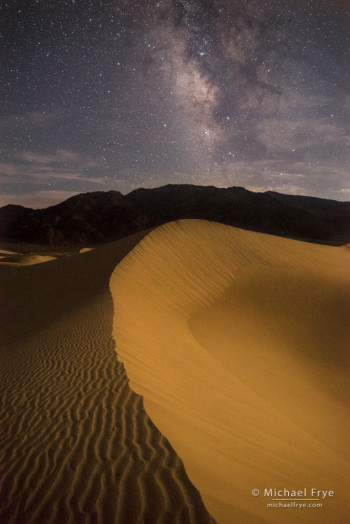
Moonlit sand dunes and the Milky Way, Death Valley. This is the photograph I originally envisioned from Death Valley, with dunes lit by the setting moon and the Milky Way above. (20 sec. at f/2.8, 6400 ISO)
Where do you go to escape the crowds on Labor Day weekend? How about Death Valley, where the temperature was forecast to be 112 degrees! That should keep the tourists away.
Okay, escaping the crowds wasn’t really the motivation for going to Death Valley in August. I had an idea for making a photograph with low-angle moonlight illuminating the sand dunes, and the Milky Way above. The moon had to be in the right phase: too much moonlight and the sky would become washed out, obscuring the Milky Way and most of the stars; too little and you wouldn’t see the effect of the moonlight on the dunes.
The moon also had to be far enough from the Milky Way to keep the moon itself out of the photograph, as it would be impossible to properly expose both the moon and the landscape in the same frame. The moon also needed to be close to the horizon, and off to the side (with the camera pointed at the Milky Way), as that low-angle sidelight would emphasize the form and texture of the dunes.
Not long ago I wrote about two apps for forecasting the position of the Milky Way and moon, PhotoPills and Star Walk. Consulting both of these apps I had figured out that the moon and Milky Way would be in the right position for the photograph I had in mind on the Friday and Saturday before Labor Day. And the next time the moon and Milky Way would be in a good position for this would be… next April, or even May. I decided to brave the heat rather than wait.
I had initially planned to go to Death Valley on Friday, but a thick bank of high clouds moved in – the remnants of Tropical Storm Marie. Since the skies looked clearer further south, Claudia and I kept driving and headed for the Trona Pinnacles.
Regular readers might recall that I went to the Trona Pinnacles for the first time in April to photograph the lunar eclipse. I really loved the place, with its surreal, otherworldly landscape. I wanted to go back to do some more night photography, so this seemed like a good opportunity, despite the heat. Trona is a little higher in elevation than Death Valley, and therefore slightly cooler, but not much. It was certainly hot when we arrived just before sunset. The thermometer in our car had stopped working, but it was probably around 105 degrees.
As day gave way to night, the temperatures gradually moderated, and the stars came out. There was a brief window when the skies were dark enough to see the Milky Way while the moon still hung above the horizon to the west. But the moon was only 18% full, which turned out to be too dim to cast any significant light on the pinnacles. But just for fun I made a photograph using the lights of our Ford Explorer, the Milky Way, and a hint of moonlight on the pinnacles:
With the moon below the horizon, the pinnacles would become silhouettes unless I added my own light. Light-painting the towers made them, if anything, even more dramatic and other-worldly, so that was perfect. During our daylight scouting I had found four sharp pinnacles well positioned to line up with the Milky Way. I lit the towers from the left side with a flashlight, with the Milky Way above:
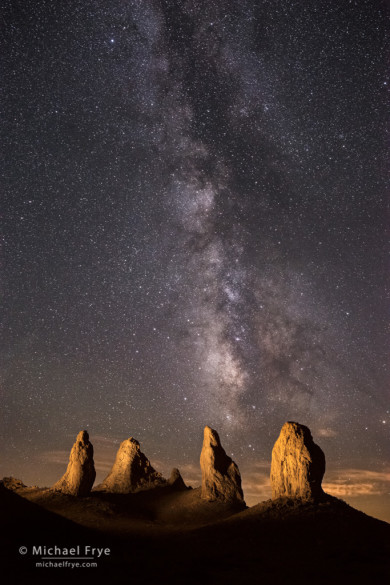
Trona Pinnacles and the Milky Way. In order to better control the light-painting, I blended together three separate exposures: one for the Milky Way (20 sec. at f/2.8, 6400 ISO), and two for lighting the rocks (each 30 sec. at f/4, 1600 ISO).
Claudia also found two isolated pinnacles beneath the north star. After composing the scene to include a lot of sky, I lit the two towers with a flashlight, and set my interval timer to capture a two-and-a-half hour star-trail sequence. Then we set up camp nearby and went to bed.
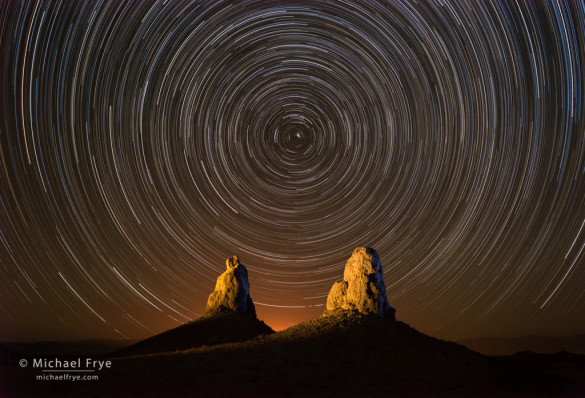
Star trails over pinnacles, Trona Pinnacles National Natural Landmark. This is a blend of 44 separate exposures: four to light the towers (various exposure times, f/8, 1600 ISO), and 40 for the star-trail sequence (each four minutes, f/8, 1600 ISO).
The next afternoon we looked for a cool place to take naps, and got the last available room at the friendly, funky, Panamint Springs Resort, about 35 minutes west of the Mesquite Flat Dunes in Death Valley. A resident cat, a Manx and Maine Coon mix called Bob, came in and took a nap with us. He must like early check-ins; if he can finagle his way into the room he has a cool place to spend the afternoon.
We had an early dinner at the resort (the food there is very good), then headed to the dunes. The clouds had gradually cleared out, so things looked promising. We arrived at Stovepipe Wells in Death Valley at about 6:30. It was still too hot to go hiking into the dunes (108 degrees according to the thermometer outside the ranger kiosk), so we killed some time by browsing in the air-conditioned gift shop. When the sun sank behind the ridges to the west we made the short drive to the edge of the dunes, loaded lots of water into our packs, and headed out.
One advantage of photographing the dunes in summer: no tracks. Few people were willing to venture very far from their vehicles in the heat, so once we skirted the area closest to the parking lot and climbed into the dunes the only tracks we found were made by kangaroo rats. And we made it out there in time to catch the sunset, with a few lingering clouds to the west turning orange and red.
After the color faded I looked for interesting dunes that might line up with the Milky Way to the south-southwest. There were several candidates, but I finally found a beautiful, curving ridge that seemed to be perfectly positioned. It was already dark enough by then, and the moon and Milky Way were in the right spots, so I didn’t waste any time, and made the image at the top of this post.
This comes very close to the photograph I had envisioned. The light is all natural, from the setting moon and stars. The moon was 27% full that night, which, with the moon so low on the horizon, turned out to be a good balance between the moonlight and Milky Way. I used my standard, dark-sky settings for the stars: 20 seconds at f/2.8, 6400 ISO.
After the moon set it was time to try light-painting the dunes. This was just too much fun, as the dunes lend themselves beautifully to light painting. I’ve put my two favorite images below; the first lit with amber light from the left, and blue light from the right, with the northern end of the Milky Way and Andromeda Galaxy above; the second just lit from the left with amber light, and the Big Dipper above. In both cases I used separate exposures for the sky and the light painting, as that gave me more control over the light. As she did at Trona, Claudia assisted by opening and closing the shutter once I was in position to light the subject. (Without an assistant I would have used my interval timer and set, say, a one-minute delay to allow me to get into position, but that’s a bit more complicated – and more work!)
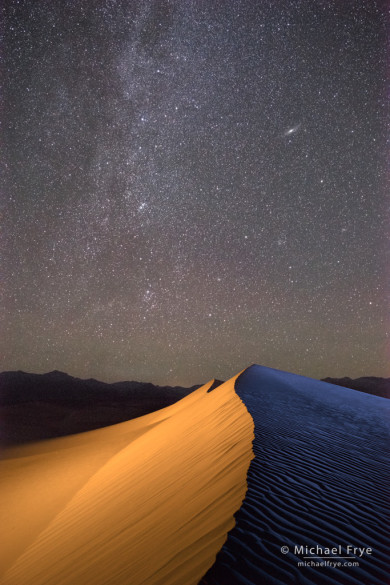
Milky Way and Andromeda Galaxy over sand dunes, Death Valley. A blend of three exposures: one for the Milky Way (20 sec. at f/2.8, 6400 ISO), two for lighting the dune (various exposure times, f/5.6, 1600 ISO).
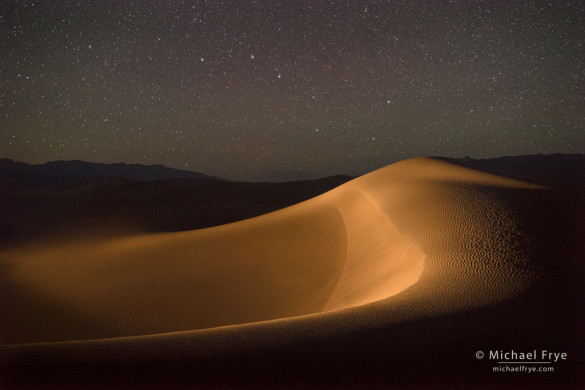
Sand dunes and the Big Dipper, Death Valley. Another blend of two exposures, one for the stars (again, 20 sec. at f/2.8, 6400 ISO), and one to light the dune (42 sec. at f/5.6, 2000 ISO).
We got back to the car well after midnight. It was still around 90 degrees by then, and we had consumed most of our water. But we had such a great time. It had been many years since I’d photographed sand dunes, and I’d almost forgotten how beautiful and serene the dunes are on a desert evening.
– Michael Frye
Related Posts: Starry Skies Adventure Workshop; Lunar Eclipse Over the Trona Pinnacles
Did you like this article? Click here to subscribe to this blog and get every new post delivered right to your inbox!
Michael Frye is a professional photographer specializing in landscapes and nature. He is the author or principal photographer of The Photographer’s Guide to Yosemite, Yosemite Meditations, Yosemite Meditations for Women, and Digital Landscape Photography: In the Footsteps of Ansel Adams and the Great Masters. He has also written three eBooks: Light & Land: Landscapes in the Digital Darkroom, Exposure for Outdoor Photography, and Landscapes in Lightroom 5: The Essential Step-by-Step Guide. Michael written numerous magazine articles on the art and technique of photography, and his images have been published in over thirty countries around the world. Michael has lived either in or near Yosemite National Park since 1983, currently residing just outside the park in Mariposa, California.

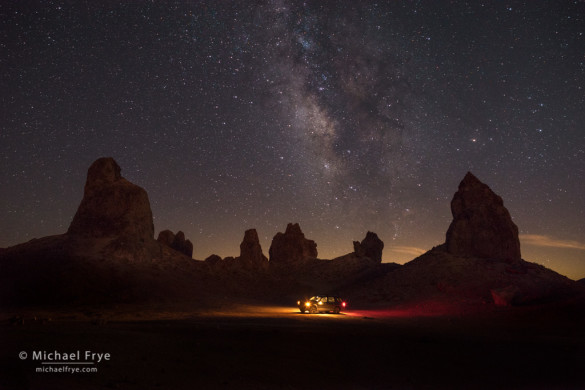
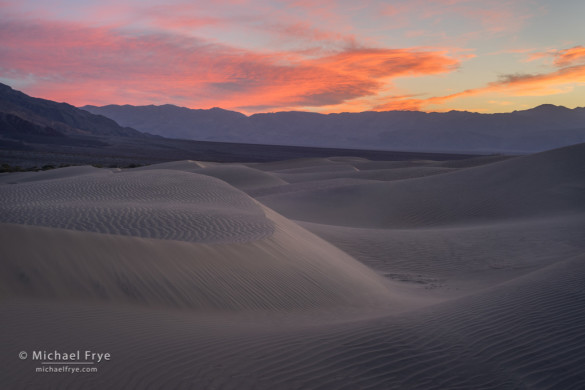
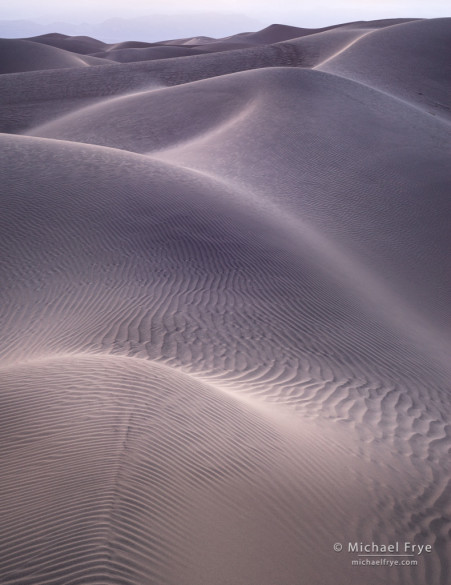








Fantastic shots. Thanks for some ideas!
Thanks Jim, and you’re welcome!
Beautiful! I love the desert, but rarely visit. Thanks!
Thank you Leigh!
Michael, wonderful post. Your enthusiasm shines through your writing. Many thanks. BA
Thanks very much Barry!
Glad you were able to create remarkable photographs while dealing with the high, desert heat (nothing new around here, lol)! The last two photos are magnificent, secretly inspiring me to visit the sand dunes just to add my footprints and signature. Death Valley is so full of life, especially if one is there when weather conditions are just about perfect. You combined the best of earth and sky in the photos. Kudos to Claudia for all her ideas and assistance, too! You make a great photo team and educational duo.
Ahem….remember this? —->have you ever held a workshop in Death Valley National Park? (Spring time, of course!) 😉
Thanks very much Ann – I’m glad you like these photos. Actually, I was thinking of doing a Death Valley workshop in July – you know, to give people the full experience. 🙂
Yes, a July experience would be the best time for workshop participants, lol!
FYI: Caught this info in today’s news:
“Scientists estimate that in about 10 years, America will have only three dark patches of land where people will be able to clearly see the Milky Way and where they’ll be able to do high-quality astronomy and nocturnal wilderness research.
Those areas are southeastern Oregon and western Idaho; northeastern Nevada and western Utah; and northern Arizona and southeastern Utah — the better part of the Colorado Plateau.”
From: http://www.azcentral.com/longform/news/local/arizona/2014/09/07/arizona-dark-skies-disappearing/15158485/
Ann, I think that estimate about only three dark patches of sky in ten years is exaggerated, but clearly dark skies have become increasingly rare, and it’s sad that so many people never see the Milky Way or Orion. Death Valley was recently named an International Dark Sky Park, and indeed the skies are pretty dark. But you can still see the glow from Las Vegas to the southeast!
Certainly is a loss to not easily see the Milky Way and Orion for the average person.
Remember when we were having the discussion regarding the light glow in the background of your Trona Pinnacle pictures? You said L.A. and I said Barstow. I suppose the bottom line is that civilization has found a way to encroach on places hundreds of miles away. Never thought about it being light glow.
Great shots! Thanks for sharing your settings, very helpful. I really want to visit that area now!
Thanks Ray! You should visit, but I suggest winter or spring. 🙂
Thanks, Michael, for sharing this post. I just recently made my first Milky Way images, and you have helped me a lot. Great photographs and technique!
Thanks Larry, and I’m glad I could help!
One of the best blog posts I’ve read in a while, Michael. Spectacular images.
Thanks so much Tony – high praise coming from you!
Wonderful images! Thanks for your excitement reflected in your writing. I have been there in March and the footprints were near impossible to deal with.
Thank you very much Robert! At popular times it can be difficult to avoid the footprints. You either have to get lucky and get some wind to clean things up, or hike way out there past where everyone else has gone.
What a fantastic set of images Michael. I could feel your enjoyment through reading your blog. Thanks for sharing, you are truly a master photographer!
And your photo “assistant” is the best!
Thanks so much Richard! And yes, my assistant is the best!
🙂
Bravo, Michael. Thanks for the method and the magic.
Thank you Bob, and you’re welcome!
Great that you took the opportunity to visit the Trona Pinnacles and come away with some great shots! I was there in July for night work and really enjoyed the spires against the night sky. Only saw one scorpion (lit up by my headlamp at my feet) and most of the time had to keep a wary eye out for snakes, but it is a fun place. BTW, it was still in the 90’s while I was there at night, so I can appreciate the need to carry lots of water. Thanks for sharing the great post!
Thanks Harvey! I don’t how many snakes there are at Trona; there’s hardly any vegetation, so not much for rodents to eat, and therefore not much for snakes to eat. But it’s always a good idea to watch where you put your hands and feet during the warmer months.
While I was there, I heard that the Mojavi Rattlesnake, the most venomous snake in North America, can migrate as far north as the Owens Lake area. Not sure if that was true, but saw a few holes in the ground around the rocks, which kept me on the lookout. They are nocturnal, which made the concern even worse, as I was out there by myself.
Well it’s better to be cautious I guess. The holes were probably made by ground squirrels or kangaroo rats. Snakes can’t dig, although they will occupy holes dug by other animals.
Sounds like a great trip, and you made some stunning photos. The amber/blue dune worked perfectly. Great idea.
Thank you John!
Wow! Great photos. Must of been “other worldly”. I hope your away from the fire Michael. Saw Little Yosemite Valley smoke video on CNN – not good. You might have other photos ops coming your way after its all done with. Stay safe Michael. Joseph :o)
Thanks Joseph!
Thank you, Michael, for such an informative post! I appreciate your explanations in what you are looking for in the night sky and all the planning you do before heading out. Seeing the Milky Way over the dunes and the spires is breathtaking…and I am sure even more so in person.
You’re welcome Vivienne, and thanks very much!
These are wonderful images. I can’t wait to be in your starry night class next year. Yes I am on the waiting list. Just an update I am so grateful for the class I took with you this year. I have become more comfortable in Lightroom and now with new vision in composition I can really enhance a good image. And the booklet you made for us is so easy to understand even when you are not there to direct.
How brave you and Claudia are to brave Death Valley in the heat! Picture was worth it.
Thanks very much Janet, and I’m glad the lessons in Lightroom helped! I look forward to seeing you again next year, if I don’t run into you sooner.
These are awe inspiring images. So Beautiful. Thank you for sharing. What kind of flashlight did you use? LED? 1200 lumens or the monster 3300 lumens..
Thanks so much Joann. I don’t use LED lights; I prefer a tungsten or halogen bulb because of the warmer color. I used a Surefire light for these images; they don’t make this light anymore, but I think it’s around 200 lumens.